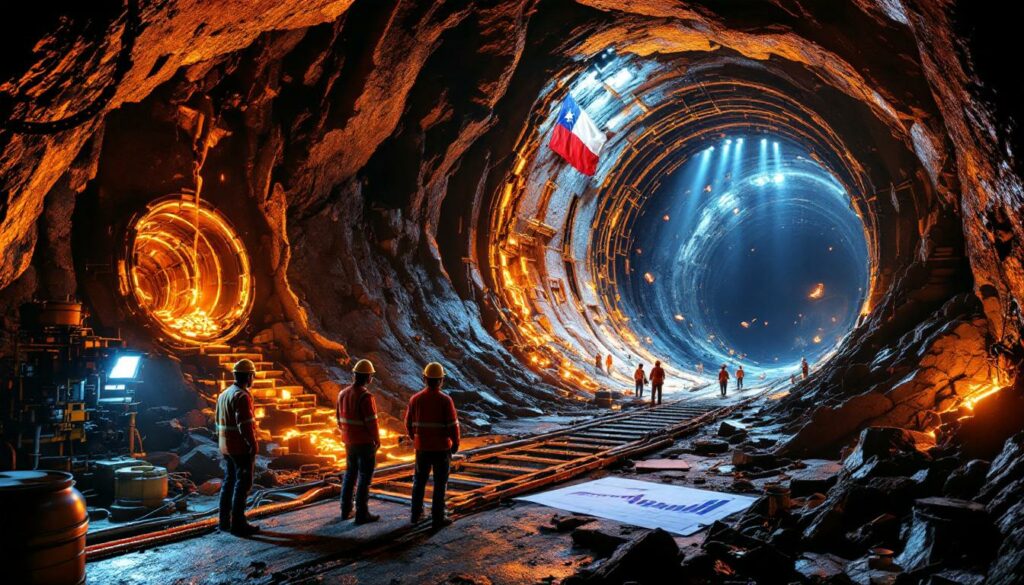Codelco's Aleniente Copper Mine Restart: Navigating Safety, Supply, and Global Impact
The global copper market is closely watching developments at one of Chile's most significant mining operations. Following a tragic incident at Codelco's Aleniente copper mine, complex negotiations are underway to restore operations while ensuring worker safety remains paramount. The situation highlights the delicate balance between maintaining critical mineral supplies and implementing rigorous safety protocols in an industry where disruptions can have far-reaching consequences.
The July 31st Incident and Its Aftermath
On July 31st, an underground collapse at Codelco's Aleniente copper mine resulted in six worker fatalities, prompting an immediate shutdown of operations. This devastating incident triggered comprehensive investigations by Chilean safety authorities, with Codelco fully cooperating throughout the process.
The impact of this shutdown extends beyond the human tragedy. Aleniente represents approximately 25% of Codelco's total copper output, making it a crucial asset for both the company and Chile's economy. The sudden production halt created significant supply concerns in global copper markets, especially given the metal's critical role in electronics, construction, and renewable energy technologies.
In response to the incident, Codelco launched internal safety reviews while simultaneously working with government investigators to determine the root causes of the collapse. Modern mine planning insights have become increasingly important in preventing such tragedies, with companies now utilizing advanced technologies for risk assessment.
Safety Disclaimer: The mining industry inherently involves risks, and companies must continuously evaluate and update safety protocols. While this article discusses safety measures, readers should consult professional mining safety resources for comprehensive guidance.
Current Status of the Restart Negotiations
Codelco has submitted a partial restart plan focusing on underground operations in areas unaffected by the July 31st incident. This phased approach aims to resume production while maintaining enhanced safety protocols in sections deemed secure by engineering assessments.
The regulatory process has been thorough, with Chilean safety authorities issuing three formal information requests, all of which Codelco has addressed. These requests likely covered:
- Detailed geological stability assessments
- Enhanced support infrastructure plans
- Revised emergency protocols and evacuation procedures
- Worker training and supervision improvements
Mining unions have advocated strongly for a phased return-to-work approach, insisting that each section of the mine receive individual safety certifications before workers return. This collaborative stance reflects a shared commitment to preventing future incidents while acknowledging the economic importance of resuming operations.
As of now, final approval from safety authorities remains pending, with regulators conducting thorough reviews of all submitted documentation and safety plans. The outcome will likely establish precedents for handling similar situations in mining operations worldwide.
Short-Term Supply Stabilization Effects
The potential partial restart of Aleniente would provide welcome relief to global copper markets currently facing various supply disruptions. Copper, essential for electrical infrastructure, renewable energy technology, and construction, has seen price volatility in response to supply uncertainties.
Industry analysts suggest that if the partial restart receives approval, production could resume in phases over 3-6 months, gradually returning to full capacity in unaffected sections. This timeline would help stabilize short-term supply concerns while longer-term safety enhancements continue in other areas of the mine.
Market response to similar historical disruptions indicates that copper prices typically experience initial spikes followed by gradual normalization as production resumes. Recent copper price prediction insights suggest this pattern may continue, though with potentially higher volatility given current market conditions.
Comparative analysis shows that without Aleniente's partial operation, the global copper supply forecast could see significant disruptions. This potential shortfall underscores the strategic importance of safely restarting operations while maintaining rigorous safety standards.
Long-Term Safety Protocol Implications
The restart plan reportedly includes enhanced safety measures that could set new standards for the industry. These likely include:
- Advanced seismic monitoring systems to detect potential instabilities
- Reinforced support structures in high-risk areas
- Real-time worker tracking and communication systems
- Regular independent safety audits and inspections
The incident has triggered industry-wide safety standard reassessments across Chilean mining operations, with regulators potentially implementing more stringent requirements for underground mining permits. These developments reflect growing recognition that safety investments, while costly in the short term, prevent catastrophic human and economic losses in the long run.
Mining safety experts suggest that implementing these improved protocols will require substantial capital investments across the industry. For Codelco specifically, the safety infrastructure upgrades represent both a necessary response to the recent tragedy and a strategic investment in operational stability.
Important Note: The implementation of enhanced safety measures often requires balancing immediate production needs with long-term risk reduction. Companies must prioritize human safety while developing economically viable operational plans.
Aleniente's Critical Role in Global Copper Supply
Aleniente's significance extends beyond its substantial production volume. The mine's copper grade—the percentage of copper in extracted ore—is reportedly higher than many comparable operations, making it particularly valuable in a market where ore quality has generally declined over decades.
The mine's processing capabilities incorporate advanced techniques for efficient mineral extraction, allowing it to maintain competitive production costs despite rising operational expenses across the industry. These technological advantages have helped maintain the mine's strategic importance even as newer operations have come online elsewhere.
Looking at reserve estimates, mining analysts indicate that Aleniente contains sufficient copper resources to support operations for many years, assuming proper management and investment. This long-term production potential makes the current safety improvements even more crucial for sustainable operations.
Strategic Importance to Chile's Economy
Copper mining forms the backbone of Chile's export economy, with the sector contributing significantly to national GDP and government revenues. Aleniente, as a major Codelco operation, plays a vital role in this economic ecosystem.
The mine provides thousands of direct jobs and supports many more indirect employment opportunities in surrounding communities. Local businesses, from equipment suppliers to service providers, depend heavily on the mine's continued operation for their economic survival.
Tax revenue generated from copper exports funds essential government programs, including education, healthcare, and infrastructure development. Any prolonged disruption to major operations like Aleniente creates ripple effects throughout Chile's economy and public services.
Compared to other Codelco operations, Aleniente's strategic importance is magnified by its production capacity and efficient operational profile. This context makes the careful handling of the restart process critical not just for the company, but for Chile's broader economic stability, as Reuters reported.
Global Resource Security Trends and Connections
The Aleniente situation unfolds against a backdrop of increasing global competition for critical minerals. Recent developments highlight this trend, including talks between the United States and the Cook Islands regarding seabed mineral exploration—conversations that come just months after the Cook Islands signed similar agreements with China.
These parallel negotiations illustrate how major economies are actively seeking to diversify mineral supply sources, particularly for metals essential to technology manufacturing and energy transition. The race for seabed minerals represents a frontier in resource acquisition strategies, with potential environmental and geopolitical implications.
The Metals Company's announcement of probable reserves for its Pacific Cabet project further demonstrates industry movement toward alternative copper sources. Deep-sea mining proposals continue to advance despite environmental concerns, driven by supply security considerations and technological innovations in extraction methods.
Cobalt Supply Restrictions: A Parallel Case Study
Similar supply disruptions are occurring in other critical mineral markets. The Democratic Republic of Congo (DRC) recently extended its cobalt export ban by three months, affecting major producers like Glencore, which has declared force majeure on some deliveries.
Despite these export limitations, Glencore reported a 19% production increase to 18,900 tons in the first half of the year, demonstrating how companies adapt to regulatory challenges through stockpiling and production adjustments. As Glencore CFO Steven Calaman noted, "any resumption in exports would be a bonus, but the company remains cautious" regarding the situation.
This parallel case highlights how market adaptation mechanisms evolve during supply disruptions. Companies develop contingency plans, including inventory management, alternative sourcing strategies, and diplomatic engagement to mitigate impacts on their operations and customers.
Investment Implications of Mining Disruptions
Major mining companies' strategic decisions often provide insight into industry trends and challenges. Glencore's recent decision to maintain its London listing despite earlier considerations of alternatives illustrates the complex regulatory calculations companies must make.
Market reactions to such decisions can be significant. Glencore experienced a 4% share drop following announcements about its listing strategy, with shares down 26% over the past year. As Glencore CEO Gary Nagel explained regarding potential US listing, "the decision remains on a watching brief" and "US listing benefits are overstated and wouldn't add any value, citing regulatory burdens and low index inclusion odds."
These corporate considerations highlight how mining companies must navigate not only operational and safety challenges but also complex financial and regulatory environments that affect investment attractiveness and shareholder value. For investors looking to capitalize on these market dynamics, copper investment strategies are becoming increasingly important.
Supply Chain Localization Efforts
In response to resource security concerns, manufacturing companies are increasingly pursuing supply chain localization strategies. General Motors recently signed a multi-year deal with Texas-based Novon Magnetics, the only US maker of sintered neodymium and iron boron magnets used in electric vehicles and other advanced technologies.
This partnership, with deliveries beginning in July, demonstrates how critical mineral supply risks are driving strategic sourcing decisions. Ford has similarly flagged rare earth supply risks, reflecting growing awareness among manufacturers about vulnerabilities in their supply chains.
China's tightening export rules on critical minerals have accelerated these concerns, prompting companies and governments to invest in alternative supply sources. These developments create both challenges and opportunities for mining operations worldwide, as regional production becomes increasingly valued for supply security reasons.
Frequently Asked Questions About the Aleniente Mine Situation
What caused the collapse at Aleniente mine?
While the full investigation remains ongoing, underground collapses typically result from a combination of geological pressures, support structure failures, and potentially operational decisions. Mining experts note that even with modern monitoring technology, predicting certain types of ground failures remains challenging.
Similar incidents in copper mining history have led to significant safety improvements, including more rigorous geotechnical monitoring, reinforced support systems, and worker training programs. The investigation at Aleniente will likely result in specific recommendations to prevent similar occurrences in the future.
When might full operations resume at Aleniente?
The timeline for complete restart depends on multiple factors, including:
- Completion of comprehensive safety assessments
- Implementation of required structural improvements
- Certification by regulatory authorities
- Training of workforce on new safety protocols
- Phased testing of systems and equipment
Mining safety experts suggest that full operational recovery could take 6-12 months for similar incidents, with production ramping up gradually as different sections receive safety clearance. This cautious approach prioritizes worker safety while allowing for economic recovery.
How is Codelco addressing worker safety concerns?
Based on industry standard responses to similar incidents, Codelco is likely implementing:
- Enhanced geotechnical monitoring systems
- Improved early warning mechanisms
- Strengthened emergency response protocols
- Additional safety training for all personnel
- Independent third-party safety audits
Union involvement in safety planning has reportedly been significant, ensuring worker perspectives inform all decisions about operational resumption. This collaborative approach helps build confidence in the safety measures being implemented.
What alternatives exist if Aleniente remains offline longer than expected?
If Aleniente's restart faces extended delays, several adaptation strategies may emerge:
- Increased production at other Codelco mines where geologically feasible
- Accelerated development of new copper projects globally
- Temporary supply chain adjustments by copper-dependent industries
- Increased recycling and material efficiency efforts
- Development of alternative materials for certain applications
Extended shutdowns typically accelerate innovation in resource efficiency and substitution while driving investment in new production capacity elsewhere. However, copper's unique properties make complete substitution challenging for many applications, underscoring the importance of responsible production restoration.
Balancing Safety and Production Needs
The Aleniente situation highlights the critical balance between production requirements and safety imperatives. Regulatory decisions must weigh economic impacts against human safety, with no perfect solution that eliminates all risks while maintaining full production.
Industry best practices for mine restart protocols typically include:
- Comprehensive geotechnical assessment of all operational areas
- Third-party verification of safety systems and structures
- Phased testing with limited personnel before full resumption
- Enhanced monitoring during initial restart periods
- Regular reassessment and adjustment of safety protocols
Different stakeholders naturally have varying perspectives on acceptable risk levels. Workers and unions typically prioritize maximum safety measures, while management must balance safety investments with economic viability. Regulators aim to enforce standards that protect workers while enabling responsible resource development.
Long-term safety culture transformation requires ongoing commitment beyond the immediate response to specific incidents. Organizations that successfully implement lasting safety improvements typically embed safety considerations into all operational decisions rather than treating them as separate concerns.
Global Resource Security Implications
Copper's central role in energy transition technologies makes supply disruptions particularly concerning. The metal is essential for:
- Renewable energy generation (wind, solar)
- Electric vehicle production and charging infrastructure
- Energy-efficient building systems
- Telecommunications and data infrastructure
Supply concentration in a few major producing regions creates inherent vulnerabilities. Chile alone accounts for approximately 28% of global copper production, making disruptions at major operations like Aleniente significant for global markets.
As copper demand surges due to electrification trends, manufacturers increasingly pursue alternative sourcing strategies, including:
- Long-term supply agreements with multiple producers
- Investment in recycling capabilities
- Research into alternative materials
- Support for exploration and development in diverse regions
- Vertical integration through mine ownership or partnerships
International cooperation mechanisms for resource security continue to evolve, with governments recognizing the strategic importance of critical minerals for economic and national security. These cooperative frameworks aim to reduce supply vulnerabilities while promoting responsible production practices.
Future Outlook for Chilean Copper Production
Recovery timeline scenarios for Aleniente and similar operations depend on multiple variables, including investigation findings, regulatory requirements, and implementation capabilities. Most mining analysts project phased recovery over 6-18 months, with initial production from unaffected areas followed by gradual expansion as safety improvements advance.
The investment requirements for safer operations represent both a challenge and an opportunity. While capital expenditures for safety improvements impact short-term profitability, they support long-term operational stability and potentially lower insurance and liability costs.
Technological innovations emerging from this incident may include:
- Advanced predictive analytics for ground stability
- Robotics for high-risk inspection and maintenance
- Improved ventilation and emergency response systems
- Real-time worker location and condition monitoring
- Enhanced communication systems for underground operations
Chile's competitive position in global copper markets remains strong despite this incident, supported by high-quality resources, established infrastructure, and mining expertise. However, maintaining this position requires demonstrating that operations can meet increasingly stringent safety and environmental standards while delivering reliable supply to global markets, as Mining.com reported.
Disclaimer: This article contains analysis of current events and potential future developments. Predictions about market impacts, timelines, and outcomes are speculative and subject to change as new information becomes available. Readers should consult multiple sources when making business or investment decisions related to the copper industry.
Ready to Spot the Next Major Mineral Discovery?
Discover why significant ASX mineral discoveries can lead to substantial investment returns by exploring Discovery Alert's dedicated discoveries page, where our proprietary Discovery IQ model transforms complex mineral data into actionable investment insights for both short-term traders and long-term investors.




